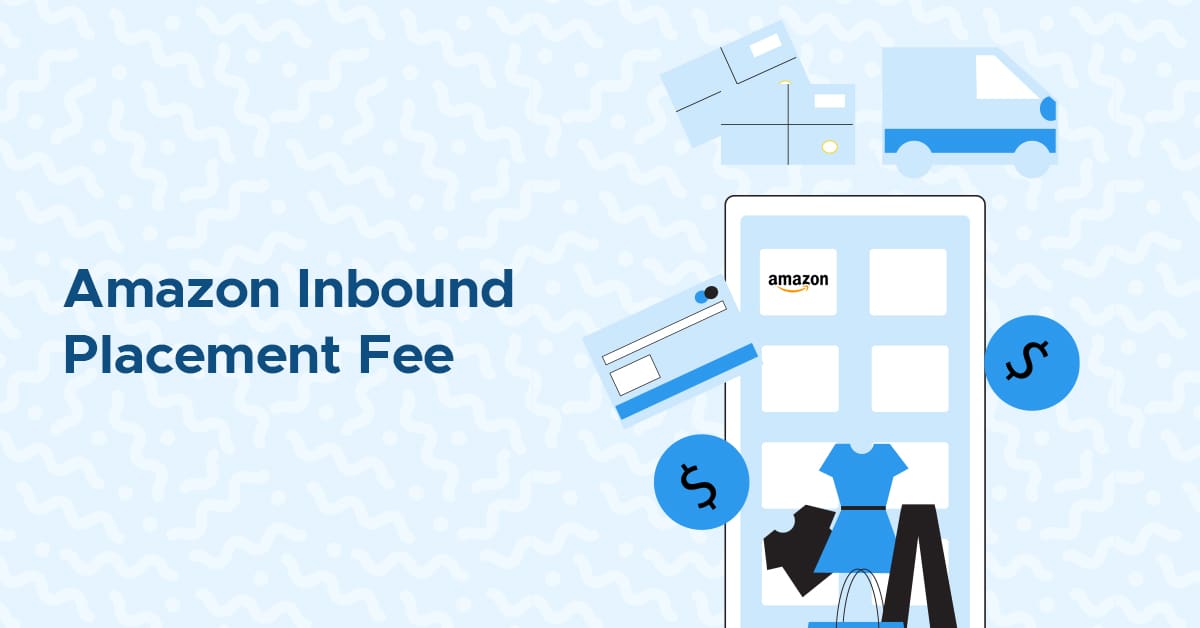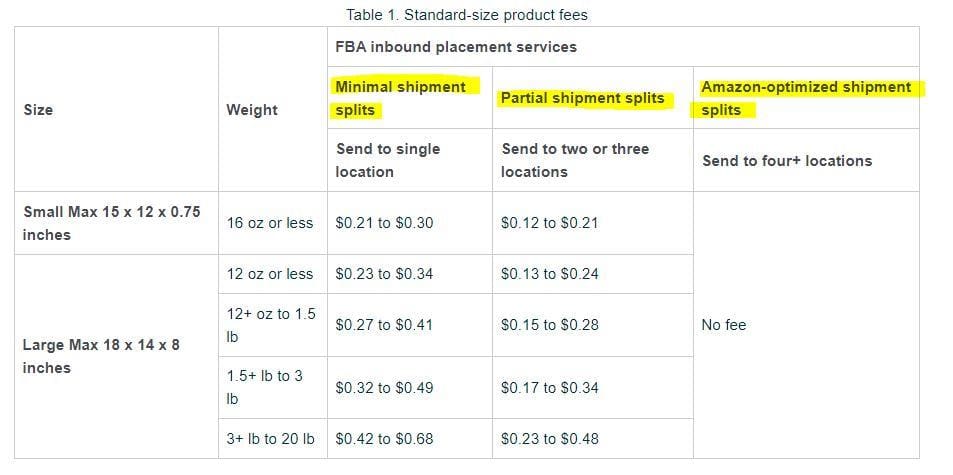
Amazon Inbound Placement Fees: What They Are and How to Reduce Shipping Costs

On March 1, 2024, Amazon rolled out their new inbound placement fees for FBA inventory. This fee is to cover the cost of splitting and sending inbound inventory to multiple locations in order to ensure fast delivery across all consumer bases. The new fee works out to: a $0.21–$0.68 per item fee for standard items and $2.16–$6 fee for large bulky and extra-large (formerly oversized) items sent to a single location and $0-$3.32 per large bulky unit sent to two to four locations.
This new fee has many sellers (and even the Federal Trade Commission) rightfully enraged. The cost of the service that Amazon had previously provided for free to boost their Prime fast shipping promise is now shifted to sellers, many of whom already have thin margins.
As a workaround to avoid placement fees, sellers used tools that create numerous inbound shipping plans automatically via the Amazon API, compared costs and fees, and then choose the options with the lowest costs. As of April 15 however, that will no longer be an option, as Amazon started charging an additional “abandoned shipment” fee. That’s left many FBA sellers scrambling to manage new fees and continue to keep costs low.
In this article, we will cover the basics of the new fees, seller response, how to minimize your inbound placement fees, and how MyFBAPrep can help thanks to strategic Amazon partnerships.
What’s new in Amazon fees
In a nutshell, Amazon’s inventory placement fees for 2024 are:
- New inventory placement fee: Standard–sized products have an average placement fee of $0.27 per unit, while for the large bulky category, the fee averages out to $1.58 per unit. However, costs vary depending on the specific item and on whether you split inbound shipments across multiple Amazon regions.
- Reduced FBA fees on most items: Amazon offers reduced FBA fees on most items for an average discount of $0.20. However, that estimate doesn’t account for new placement fees.
- Fees for low inventory: Products that have an average of less than 28 days of inventory in stock will receive a fee. These vary depending on the product, but we’ve seen quotes as high as $0.89 per unit. To encourage inventory increases, Amazon decreased non-peak storage costs by about $0.09 per cubic foot as of April 1.
- Fees for abandoned shipping plans: As of April 15, 2024, sellers will be charged a fee for abandoned shipping plans. Abandoned shipping plans means any shipping plan which is approved by the seller and then not used. This is likely Amazon’s response to vendors using third-party software to generate shipping plans and approving them to see how Amazon automatically splits them, until they find an option with no fees.
Amazon’s new inbound placement fees for 2024
Amazon launched their new inbound placement fee on March 1, 2024. Unlike old placement fees, which only applied to oversized (now large bulky) products, the new ones also encompass small and lightweight as well as standard-sized items. Standard items now have an average placement fee of $0.27 per unit, while large bulky products see a median of $1.58 across all shipment split configurations. However, for large-bulky products shipped to a single Amazon region, that’s a median of $4.08 per inbound unit.
However, actual fees depend on the placement service:
- Minimal shipment splits: Send to one location, pay maximum fees/no fee discount
- Partial shipment splits: Send to two locations, pay fees with a discount
- Amazon-optimized shipment splits: No fee/100% fee discount

These discounts will also pertain to large bulky items, although the base fees are different. For example, fees start at $2.16–$2.67 for large bulky items (max 59” x 33” x 33”) weighing five pounds or less and reach up to $6 per item if the item is 42–50 pounds. However, you can also receive the up-to-100% discount by shipping your product to four or more locations.
Seller responses to new inbound placement fees
Sellers have had mixed opinions on the recent inbound placement fees. For most, it’s an unwelcome set of new expenses that require juggling inventory and shipment. That’s especially hard on vendors who normally import directly from China and ship to a warehouse. Splitting up those shipments immediately means either making smaller orders and paying for separate costs or implementing a separate FBA prep solution in between, both of which increase expenses.
Some sellers also report astronomically high fees, such as $300 placement fees compared to $122 delivery fees. Another seller on the same forum, meanwhile, quoted an increase of $12 in shipping fees and a $360 placement fee, which they were able to offset by splitting the shipment into four boxes, but it still increased their shipping costs to $30.
Like we previously mentioned, many sellers initially used the API to generate shipping plans systematically until they found an option with no fees. As of April 15 though, that’s no longer an option since you’ll pay a fee for deleted and abandoned shipments.

Those fees can be high in their own right:
| Product size tier | Weight | Deleted and abandoned shipments |
| Small standard Max 15 x 12 x 0.75 inches |
16 oz or less | $0.02 |
| Large standard Max 18 x 14 x 8 inches |
12 or less oz | $0.02 |
| 12+ oz to 1.5 lb. | $0.02 | |
| 1.5+ lb. to 3 lb. | $0.03 | |
| 3+ lb. to 20 lb. | $0.04 |
In short, you shouldn’t try to game Amazon by programmatically adjusting your shipments until you cut expenses. However, you need to understand the new fees so you can reduce them as much as possible in your initial shipping plan.
How to minimize your inbound placement fees
Minimizing fees under the new inventory placement fees for 2024 means you’ll have to ship more inventory in at once to reduce fees and maintain 30-60 days of inventory. You’ll also want to take advantage of the Ships in Product Packaging (SIPP) program when possible, as you’ll receive a discount of $0.04–$1.32, depending on the product size and weight.
It’s important to cut your inbound shipping fees to maintain profitability. In fact, while many sellers are feeling the pinch of added expenses, others are already optimizing shipping plans to reduce costs.
You would ideally select “Amazon Optimized Shipment Splits” for every order so it can ship to four or more locations. Unfortunately, Amazon handles this distribution automatically, provided your “Amazon Optimized” is selected by going to Settings -> Fulfillment by Amazon -> Inbound Settings -> Inbound Placement.
Amazon considers the size of products, geographical demand, distribution of items in boxes, and number of boxes in the shipment. That means you can increase your chances of qualifying for no placement fee by:
- Having four to five boxes with every inbound shipment, although sometimes you’ll need more (e.g., if Amazon sends two-thirds of your shipment to a single location, you’d have to account for that and increase the number of boxes accordingly so you still secure four locations)
- Creating separate shipments for standard-sized items, non-standard items, and special handling categories
- Ensure item mix and quantities are split evenly across boxes
What MyFBAPrep can do
MyFBAPrep has Amazon partnerships that can help us reduce costs. We spoke with multiple sources in and out of Amazon to get the best recommendations on how we can help our sellers reduce their overall costs.
MyFBAPrep can batch your inventory with other sellers that need to go to the same region or FBA warehouse to streamline operations. Shipping full truckloads with multiple customer goods can save on inbound fees as it’ll help you affordably take advantage of shipping to multiple areas.
FBA locations are split into various regions. This map is constantly changing, but a rough guide of area splits are:
- Northwest
- Southwest
- Texas
- Midsouth
- Florida
- Midatlantic
- Northeast
- Midwest
- Great Lakes
Among these regions, there are cross-regional pairings. So that means we can send a full truckload shipment that covers multiple regions, further saving on costs.
For example, if your Amazon inventory plan asks you to send to two different regions in the Northeast, Southeast, and Central East groupings, we can send one full truckload to those regional pairs instead of two separate trucks.
Again, these are constantly changing, but here’s an example of what regional pairings might look like:
- Midwest regions
- Southwest and West-East regions
- Northeast, Southeast, and Central-East regions
- Larger Northeast regions
Essentially, the goal is to maximize full truckloads. If they fall into region pairs, instead of doing splits we can also strategically filter shipment creations to two or three splits, then regionalize it. So doing a few splits in the Eastern region means they can all go out on one truck with our Amazon partnership resources.
Wrapping up — Strategize now to weather the waves of Amazon fees
Amazon’s inbound placement fees are hitting many sellers hard. Worse, Amazon is eliminating the go-to workaround of creating and abandoning multiple shipment plans to find optimal routes. Even if you’re able to avoid placement fees by using Amazon’s optimized shipments, you will face higher shipping expenses as a result. Careful inventory management and planning while shipping to four or more locations can keep costs and these new fees to a minimum. Plan wisely and seek help when necessary to keep your head above water and your business in the black.

